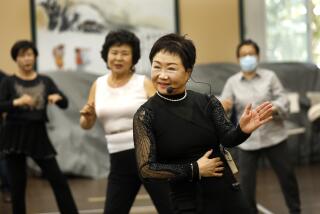DANCE REVIEW : Karpatok Ensemble in Step With Hungarian Rhythms
- Share via
COSTA MESA — At a time when much of Eastern Europe is undergoing upheaval, Eastern European dance is holding fast to tradition--at least when it comes to its practitioners here in Southern California.
Karpatok Hungarian Folk Ensemble, the veteran Los Angeles-based dance and music troupe, presented a polished and lively evening of more than two dozen works to an appreciative full house at the Robert B. Moore Theatre at Orange Coast College over the weekend.
With a formula for success that is equal parts dance, music and festive costuming (by Wendi Kiss), Karpatok suggests the countryside roots of its art form without sacrificing virtuosity or showmanship. The 40-member company’s emphasis is on teamwork and the larger terpsichorean picture, not on feats of individual prowess.
Circle dances, men’s and women’s formation dances and a few loosely narrative works illustrated a variety of strains with Hungarian culture, from regional styles to Szekazardi Gypsy and Croatian variations.
As Karpatok artistic director Tibor Toghia explained in a program note, the company’s view of what constitutes Hungarian culture is broadly inclusive, not limited by “the current territory now designated Hungary on the map.”
Throughout the eclectic program, women in brilliantly colored full-skirted dresses and men in traditional outfits of predominantly black, white and red wove in and out of complex choreographies, often with the dancers singing as well.
The 32 dancers--most of whom are of Hungarian descent--keep the energy level high, with synchronized, rhythmic thigh-slapping, clapping and boot-stomping steps. The men are characteristically athletic, mildly aggressive and gallant, while the women remain more dainty, although not overly demure.
Crowd pleasers included “Tolnai Uveges Tanc”, a circle dance in which the female performers balanced glass decanters of wine on top of their heads and “Ecsegi Kanasztanc,” an upbeat herdsmen’s dance full of male bonding and bravado.
On a more somber note, “Katona Kisero” re-created a scene with young men leaving their village to go to war--suggesting, perhaps unavoidably, comparisons to current U.S. military action in the Persian Gulf.
In addition to providing skilled accompaniment, Karpatok’s six instrumentalists also played four featured segments, including Brahms’ familiar Fifth Hungarian Dance.
More to Read
The biggest entertainment stories
Get our big stories about Hollywood, film, television, music, arts, culture and more right in your inbox as soon as they publish.
You may occasionally receive promotional content from the Los Angeles Times.










